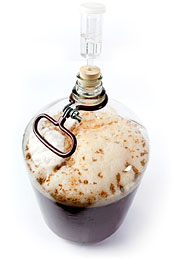 Over on the E. C. Kraus Wine Blog, Ed has been sharing some of the key winemaking terms used by professional and hobbyist winemakers.
Over on the E. C. Kraus Wine Blog, Ed has been sharing some of the key winemaking terms used by professional and hobbyist winemakers.
A great deal of jargon also surrounds the world of brewing. To help you talk like a brewer and improve your craft, here are some of the brewing and beer terms you should add to your playbook:
- IBUs – IBUs stand for international bittering units, which measure the amount of alpha-acids (the part of the hop that contributed bitterness) that are isomerized during the boil and absorbed into the beer. IBUs range from the single digits for light lagers, lambics, and wheat beers and up to 100 or higher for Imperial IPAs and barley wines. Check out this IBU range chart for bitterness ranges for different beer styles.
- Krausen – Krausen is just a German word that refers to the foamy layer of yeast and protein that sits on the top of wort at the height of fermentation. The peak is sometimes referred to as “high krausen”. (You may hear reference to a practice called “krausening”. It’s an interesting technique, but neither practical nor necessary for the average homebrewer.)
- Phenol – Phenol is an aromatic byproduct of the fermentation process, produced by yeast. Depending on the style, phenol may or may not be desirable. For example, German weizens are expected to have a certain level of spicy, clove-like phenols. In other beers, undesirable phenols may be produced by excessive fermentation temperatures. This is one of the reasons why controlling fermentation temperature is so important.
- Hot Break – The “hot break” is the point in the boil where proteins coagulate and start to foam on top of the boiling wort. This is normal. Too much hot break and the wort can boil over, creating a big mess and an even bigger headache. If it looks like you’re about to have a boil-over, you can remove the pot from the heat source or quickly add a dose of cold water.
- Cold Break – The cold break happens during the cooling of the wort, prior to pitching the yeast. Chilling the wort rapidly ensures helps proteins settle out of suspension, which helps avoid haze when the beer is ready to serve. Immersion wort chillers are one of the best ways for homebrewers to chill wort quickly.
- Adjuncts – Adjuncts are sugar sources other than barley malt that increase gravity or affect flavor in some way. Some adjuncts are used for head stability. Examples include wheat, various sugars, and more.
Are there any homebrewing terms you’d like to learn more about? Leave a comment below!
————————————————————————————————–
David Ackley is a beer writer, brewer, and self-described “craft beer crusader.” He holds a General Certificate in Brewing from the Institute of Brewing and Distilling and is founder and editor of the Local Beer Blog.
